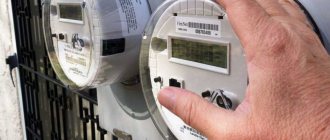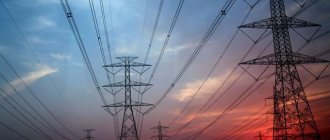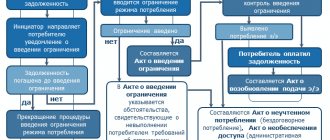04 April 2019
Adviсe
Why can a meter malfunction or interference with its operation lead to costs of hundreds of millions of rubles and how to prevent this?
Entrepreneurs who use large real estate assets fear energy sales inspectors more than the tax inspectorate. One of the reasons is that if the electricity meter fails or the inspector detects interference with its operation, then the electricity consumption will be considered unaccounted for. In this case, the amount of electricity consumed can be recalculated.
The number of cases of unaccounted consumption is growing every year. The amounts of claims reach hundreds of millions. At the same time, judicial practice in such cases is heterogeneous, since the court needs to prove specific circumstances. Relying on similar disputes is almost pointless.
In what cases is electricity consumption considered unmetered?
The grounds for concluding that electricity consumption is unaccounted for are specified in paragraph 2 of the Rules approved by Decree of the Government of the Russian Federation of May 4, 2012 No. 442.
The most common among them are:
- failure or damage of the seal on the metering unit - such units may include meters and current transformers;
- impact on the metering device, for example using a magnet, is detected if there is an anti-magnetic seal;
- mechanical interference with the operation of the meter or other actions that affected its operation;
- Violation of the meter verification period or the procedure for notification of its malfunction.
You can read about what to do if the verification period for a meter expires, the seal is damaged or the meter is broken in the publication “Replacing a meter: how to avoid becoming a victim of a fraudster.”
Unmetered electricity consumption
Dear Customer! This section is designed to prevent actions (inactions) of electricity consumers that could lead to recording unmetered electricity consumption .
What is unaccounted consumption?
The concept of unmetered electricity consumption is formulated by the Basic Provisions for the Functioning of Retail Electricity Markets (approved by Decree of the Government of the Russian Federation No. 442 of May 4, 2012).
In simple terms unaccounted consumption is a violation of contractual obligations on the part of the consumer, which is expressed by:
- in interfering with the operation of the metering device,
- unauthorized connection of wiring to the metering device,
- damage (self-removal) of seals, including antimagnetic and other visual inspection signs,
- untimely notification of the loss of a meter or its malfunction,
- in other actions that distort meter data.
Unmetered consumption can be identified by the network organization or specialists of Tomskenergosbyt JSC.
Unaccounted-for electricity consumption can be identified both in relation to legal entities and in relation to individuals purchasing electrical energy for household needs.
Consequences of unaccounted consumption:
An act of unaccounted electricity consumption drawn up when a violation is detected is the basis for:
- charging the consumer the cost of unaccounted for consumed electricity,
- introducing restrictions on the consumption regime for the consumer for arrears of payment for unaccounted for consumed electricity,
- recovery of the cost of unaccounted for consumed electricity from the consumer in court (if the consumer refuses to pay voluntarily).
The volume of unmetered consumption of electrical energy is determined:
- for legal entities - based on the maximum power of power receiving devices, determined by documents on technological connection, and their round-the-clock operation, or on the permissible long-term load of the supply cable,
- for individuals purchasing electrical energy for household needs:
- in case of unauthorized connection of indoor equipment - based on the power of the unauthorized connected equipment and its round-the-clock operation, or based on the volume determined on the basis of the electricity consumption standard with an increasing factor of 10 applied to such volume;
- in case of unauthorized intervention in the operation of the meter based on the volume determined on the basis of the standard for electricity consumption with the application of an increasing factor of 10 to such volume.
Thus , the consequences that occur for the consumer as a result of identifying unmetered electricity consumption lead to a multiple increase in the volume and cost of electricity to be paid in comparison with the cost of electricity calculated based on the readings of a properly functioning meter. At the same time, the responsibility and costs for restoring the functionality of the metering device also lie with the consumer.
Arbitrage practice:
On the fact of collecting from consumers the cost of unmetered electricity consumption, extensive judicial practice has been formed, which confirms the position of the courts on satisfying claims against a consumer who has committed such a violation.
As an example, we can cite several legal proceedings on the basis of non-payment of receivables, which were formed as a result of the amount payable for consumed electricity under an act of unaccounted consumption:
- Case No. A67-6226/2017. Statement of claim in the amount of RUB 12,657,303.34. An act on unaccounted electricity consumption was drawn up, according to which the consumer, upon inspection of the measuring complexes of input No. 1 and input No. 2, found that in the voltage circuits IK-1, IK-2 (in phases “A”, “B”, “C” ), detachable connections (clamps) were found under the removable panels covering the cable channels. The claims were satisfied in full.
- Case No. A67-8239/2017. Statement of claim in the amount of RUB 572,453.83. Based on the detected violation, a report on unaccounted electricity consumption was drawn up. According to this act, upon inspection, the consumer was found to have interfered with the metering scheme by breaking the seals and changing the power supply to the settlement meter with its complete stop. Disconnection of the secondary circuit of phases A, B, C. The claims were satisfied in full.
- Case No. A67-129/2018. Based on the fact of violation of the metering scheme, a report on unaccounted consumption of electrical energy was drawn up. When checking the electrical energy metering circuit of the metering device installed in the ASU-0.4 kV boiler room, it was revealed that there was no seal installed by the network company on the terminal cover of the metering device. RUB 44,038.60 collected
- Case No. A67-225/2017. An act of unaccounted consumption was drawn up, because when checking the measuring complex, it was revealed that there were no seals installed by the network company on the terminal cover of the meter, the panel of the input device, current transformers, and the terminal block for breaking the secondary switching circuits of current and voltage transformers. RUB 5,359,771.78 collected The appeal decision upheld the decision.
How to avoid unmetered consumption of electrical energy?
To avoid the consequences of unmetered electricity consumption, you need to:
- monitor the serviceability of metering devices (measuring complex),
- carry out timely verification of the measuring complex,
- immediately notify the guaranteeing supplier and (or) the network organization about the loss of the metering device (measuring complex) or its malfunction, in a way that allows you to confirm the fact of sending the notification,
- If it is necessary to replace a metering device, in no case will you unauthorizedly remove the seals from the metering device, current transformers and other equipment included in the measuring complex in the absence of a network organization or a guaranteeing supplier .
The procedure for dismantling a metering device for the purpose of its replacement, repair and verification, approval of the measuring complex, the list of mandatory participants in the procedures is determined by the requirements of Section X of the Basic Provisions for the Functioning of Retail Electricity Markets (approved by Decree of the Government of the Russian Federation No. 442 of May 4, 2012).
How and by whom is unaccounted consumption detected?
Unmetered consumption is detected when the meter is checked by the owner of the electrical network or the electricity seller (sales company).
During the inspection, an inspection report (check) of the meter is drawn up, and if interference in its operation is detected, a report of unaccounted consumption is drawn up. The rules for checking the consumer and drawing up an act of unaccounted consumption are specified in paragraphs 169, 172, 176, 177, 192, 193 of the Rules approved by Government Decree No. 442.
Violations in checking and drawing up an act of unaccounted consumption may become grounds for the court to refuse to collect debt for electricity from the consumer.
Often inspectors commit the following violations:
- the consumer was not notified of the upcoming inspection, and he was absent at the time of its conduct;
- the witnesses indicated in the act of unaccounted consumption cannot confirm the fact of unaccounted consumption, or it is impossible to prove their presence;
- the act of unaccounted consumption does not contain information about how the interference with the operation of the meter was carried out, and evidence of this information - photographs;
- the act of unaccounted consumption is drawn up a considerable time after the meter check and not at the place where it was carried out, which does not allow assessing its reliability.
How is electricity consumption paid without a meter?
Source: EnergoVOPROS. ru, 01.08.2018
https://energovopros.ru/issledovania/2322/2326/41611/
How to pay for electricity without a meter? In what cases should the consumer pay according to average consumption, and in what cases - according to the standard? In what cases is the fee charged according to the standard with an increasing factor? And how, after all, is it more profitable to pay for electricity - according to the meter or according to the standard? Visitors to EnergoVOPROS.ru often ask these kinds of questions. Let's try to figure it out.
Paying for electricity without a meter: what the current legislation says
Probably everyone knows how electricity charges are calculated if an electricity meter is installed and working properly in an apartment.
There is a counter. There is his testimony. Take the number of kilowatt-hours spent per month and multiply it by the current tariff in your region. You receive the amount you need to pay for electricity consumption. It's simple!
But how is electricity payment calculated without a meter? Current legislation reduces the variety of life situations to the following options:
- there is a meter, but its readings were not transmitted on time (in accordance with the established procedure)
- There is a meter, but it turned out to be faulty (it broke down, the verification period has expired)
- There is a meter, but representatives of the energy supply service provider are not allowed to see it
- there is a meter, but upon inspection it turned out that it was deliberately damaged (or electricity was connected past the meter)
- Finally, there is simply no counter. And this situation is by no means uncommon.
How the fee for electricity supply service is calculated in each of these cases is described in detail in the Rules for the provision of utility services.
This document was approved by Government Decree No. 354 of May 6, 2011 No. 354 “Providing utility services to owners and users of premises in apartment buildings and residential buildings.” Since then, numerous changes have been made to it. The current version of the Rules can be found, for example, here.
Following the Rules, let's look at the options listed above.
Payment for electricity if meter readings are not submitted on time
Start over. In order to be able to pay for electricity based on meter readings, you need to transfer these readings to the person who supplies you with electricity.
How to transmit meter readings? When? To whom? These questions are quite appropriate and deserve separate analysis. In short, the readings are transmitted either to the energy sales company (your electricity supplier), or to the management company of your home, or through a city (regional) settlement center.
There are also several other ways. But here and now it is important to note that if the meter readings are not transmitted, then you will not be able to pay for electricity using them. Looks fair.
So, if you have not provided meter readings, the electricity fee is determined based on your average monthly consumption.
“Average monthly” consumption in this case is calculated based on the readings you took (or they were obtained, for example, during a check of your meter) over the past six months.
The exception referred to in the Rules is in cases where payments on the meter began less than six months before the moment you did not transmit its readings. For example, the meter was delivered to you in June, but in October you did not provide the readings. In this case, your average monthly electricity consumption for the period of actual operation of the meter is taken as a basis. But not less than 3 months.
You didn’t submit your testimony for one month, the second, the third... What’s next? Starting from the fourth month, during which you do not submit meter readings, you will be transferred to payment according to the standards. See what it looks like here.
If you are interested in how the above is formulated in the Rules for the Provision of Public Utilities, then you need to study clause 59 (b) of this document.
Payment for electricity if the meter is (was) found to be faulty
Let's imagine: you somehow discovered that your meter is faulty. It was destroyed during repair work. Damaged in a fire. It just stopped working, and even you can see it. Alternatively, it was stolen. Either its verification period has expired, or its service life has expired... How is the payment for light calculated in this case?
The situation is described in paragraph 59 (a) of the Rules for the Provision of Public Utilities. First of all, the moment of occurrence of the “event” is determined, that is, when exactly the metering device is recognized as faulty (lost)?
This may be the date of your statement to the energy sales company about a faulty meter. Or the date of drawing up a report on the malfunction of the meter based on the results of its inspection by an inspector. Or the expiration date of the meter's verification interval. If there is no exact date, then the month (payment period) in which the “event” occurred is taken as the “reference point”.
From this date you will be transferred to payment based on average monthly consumption. Average monthly consumption is calculated in the same way as in the previous paragraph - based on the last six months.
However, “on average” you will only be paid for three months in a row. After which they will transfer to payments according to the standard. How the electricity fee is calculated according to the standard, see here.
It is worth noting that for some time now, consumers whose electricity meter has failed and who have been living without a meter for more than three months have been charged according to the standard with an increasing factor of 1.5. So it would be good to hurry up with the installation of a new meter.
Separately, it is worth considering the case when a malfunction of the meter is discovered during a meter inspection by a representative of an energy sales company, and the inspector insists that there was unauthorized interference in the operation of the meter. The list of signs of such interference is given in clause 81.11 of the Rules.
Violations must be described in a special Act. From the date of its signing, electricity consumption is recalculated based on the standard increased by 10 times (pro-standard, again see the link).
The recalculation period is three months preceding the date of detection of the violation and until the date of their elimination (which in most cases means replacing the meter).
There is a meter, but representatives of the energy sales company are not allowed to see it. How are electricity charges calculated?
First, let's define what does “not allowed” mean? Often, electricity meters are installed directly in the apartment or in the vestibule, access to which from the landing is closed with a “good iron door” (c).
That is, it is not so easy for an outsider to get into the meter. At the same time, energy sales inspectors have a habit of visiting subscribers during working hours. They do not travel at night or early in the morning. This means that they have little chance of crossing paths with the apartment’s inhabitants.
Just for such a case, the Rules for the Provision of Utility Services detail the procedure that the energy sales representative must follow in order to agree on the inspection time with the apartment owner.
Representatives of the electricity supplier organization are required to notify the owners of the apartment being inspected in advance. Those, in turn, must confirm that they will be at home at the proposed time.
They don't confirm? This means that the utility service provider is obliged to send a second notification. If it is not possible to agree on a date for the visit the second time (or the inspectors came at the agreed time, but there is still no one at home), then a special document is drawn up - an Act on the refusal of the contractor’s access to the metering devices.
Each iteration of this complex procedure is described in detail in paragraph 85 of the Rules. If you really need to know exactly who should do what and in what order? - be sure to read it.
From the date when the Certificate of Denial of Admission is issued, the consumer is transferred to payment based on average monthly consumption. If the issue with checking the meter is not resolved within three months, then you will begin to receive payments for electricity, calculated according to the standard.
How is the payment for electricity calculated if the meter is deliberately damaged, or (as an option) electricity goes to the apartment, bypassing the meter?
It was already written about a little higher. This situation is the most unpleasant for the consumer. The method of payment for electricity in such circumstances is described in clause 62 of the Rules for the provision of utility services.
So, during the inspection, the inspectors discovered that your electric meter was deliberately put in a faulty state and counts the electricity in “your favor”, or the electricity in your apartment (house) was supplied past the meter. What will happen next? The consequences are quite severe.
Utilities have the right to charge additional charges for electricity based on the total number of electricity consumers in an apartment (private house) and the maximum power they consume. The calculation is made based on the fact that electricity consumption occurs around the clock. And the additional charges themselves are made for three months preceding the elimination of an unauthorized connection past the meter.
If it is impossible to determine which electricity consumers are in the apartment and what their maximum power is, then the payment for electricity in this case is calculated based on a standard increased tenfold.
Read about the standard below; here it is worth noting that the amounts accrued in this way are several times, or even an order of magnitude, higher than the fee for actual electricity consumption.
As in the case of calculations based on maximum power, recalculation according to a 10-fold increased standard is made three months prior to the removal of the connection to the electrical networks past the meter.
A small clarification - if inspectors visited you less than three months before the violation was discovered and nothing “criminal” was found, then the calculation of electricity charges based on the maximum possible consumption (or 10 times the standard) will be made from the date of this visit.
How to pay for electricity if your apartment does not have a meter? And/or never happened? Those. according to the standard?
Electricity meters are, of course, not water meters, which began to be installed en masse only in the last decade.
It was mandatory to equip apartments with electricity meters back in Soviet times. And yet, many apartments (one of the most common cases are apartments in former dormitories) and private houses still do not have meters. Payment for electricity in this case is calculated according to the standard.
The standard in this case is the calculated value of electricity consumption in a residential premises, which is tied to the number of rooms in the apartment and the type of its amenities (gas stove or electric).
In the Rules for the Provision of Utility Services, the issue of payment for electricity according to the standard is dealt with in paragraph 42. Let's go through it.
So, three indicators are taken:
- number of citizens permanently or temporarily residing in residential premises
- electricity consumption standard, it is determined for each region by a separate decision of local authorities
- electricity tariff valid for this type of consumer
These three figures are multiplied and the cost of electricity is obtained, which is indicated on the payment invoice.
To this it is worth adding the following:
First: if no one is officially registered in the apartment (either permanently or temporarily), then the standard fee is calculated based on the number of homeowners
Second: the authorities strongly want electricity meters to be installed in all houses and apartments, so if the residential premises are not equipped with an electricity meter, then the standard fee is charged with a coefficient of 1.5 (without a coefficient, the standard fee is charged in cases where the meter is there is, but his readings are not transmitted).
What is more profitable: according to the meter or according to the standard?
People often ask: what is the best way to pay for electricity? According to the standard or, nevertheless, according to the meter, without spending money on its purchase and installation?
Generally speaking, the answer would be:
- if more people actually live in the apartment than officially registered, then paying according to the standard may be more profitable,
- and if, on the contrary, more people are registered than live, then, of course, it will be cheaper to pay for electricity using the meter.
Well, if you are interested in specifics, you need to look for a decision from the tariff authority of your region, which approved consumption standards. Next, arm yourself with a calculator and count.
But still, we would venture to assume that in most cases it will still be more profitable to install a meter.
How is the amount of unaccounted consumption calculated?
The calculation procedure for unaccounted consumption is specified in clauses 194, 195 of the Rules approved by Government Decree No. 442.
It is made according to a formula that takes into account:
- the number of hours of consumption from the date when the meter was last checked until the report was drawn up;
- the power that the consumer can use is indicated in the energy supply contract.
It is these indicators - the number of hours of consumption and power - that need to be checked to be sure that the invoice is correct.
It is important to know:
- the calculation can be made for a period of no more than 1 year;
- from the total amount, the sales organization is obliged to exclude the amount that the consumer paid for electricity during the period of unmetered consumption;
- the sales company can be asked to provide installments, i.e. payment can be made in installments;
- failure to pay the bill within the time period established by the energy supply contract may result in a power outage;
- The energy supply contract may contain a condition regarding the operating hours of the consumer’s facility, for example from 9:00 to 22:00. In this case, the number of hours of unaccounted consumption will be less, which will affect the final bill.
Is it possible to appeal an act of unaccounted (unaccounted) consumption?
Arbitration courts in most cases say that the act of unaccounted consumption and the issued invoice do not indicate a violation of consumer rights.
Therefore, they cannot be appealed. But courts often do not take into account that failure to pay a bill entails a violation of rights in the form of a power outage. If you are an entrepreneur, it would be better to pay part of the invoice first. Then apply to the arbitration court with a claim for recovery of unjust enrichment, that is, the previously paid amount on the invoice. As part of this dispute, it will be necessary to prove the absence of grounds for issuing an invoice. When filing a claim, you can apply for interim measures in the form of a ban on turning off electricity.
What needs to be proven in court to win a dispute over unmetered electricity consumption?
- The metering device was checked with violations that did not allow the consumer to provide their evidence.
- The act of unrecorded consumption has inaccuracies that indicate its unreliability and inadmissibility.
- The fact of unaccounted consumption is not confirmed by the act of unaccounted consumption, and there is no other evidence.
- There was no impact on the metering device. To prove this, it may be necessary to conduct an examination or involve an energy specialist in the case.
Who is responsible for unmetered electricity consumption: the owner or the tenant?
It happens that the premises in which unaccounted consumption has been identified are rented out.
In this case, the person who is responsible for ensuring the safety of the electricity meter will have to pay for electricity. The building owner may not have access to the meter. But in order to recover damages in connection with payment for unmetered consumption from the tenant, it is necessary to prove that it was he who had access to the meter and was obliged to service it and take readings. If this obligation is not provided for in the contract, the owner will have to pay the bill. It will be difficult to collect this amount from the tenant.
Electricity consumption standards
Consumption standards are used to calculate payments for utility services in cases where the owner does not transmit meter readings, that is, it is impossible to determine the actual consumption of the service. If the readings are not transmitted due to a breakdown of the meter, then for the first three months he will be charged for electricity according to the average monthly consumption, and from the fourth - according to the standards. If there is a meter, but the owner for some reason does not provide readings, then the standards begin to apply from the fourth month. Until this point, the calculation is also based on average monthly consumption.
We remind you that if a resident of an apartment building has the technical ability to install a meter, but does not have a meter, then when charging for electricity, an increasing factor of 1.4 is applied to the standards. From January 1, 2017, the increasing coefficient will increase to 1.5.
Electricity consumption standards were approved by the “Resolution of the Government of the Krasnoyarsk Territory dated October 11, 2016 No. 518-p “On approval of utility consumption standards for electricity supply in the Krasnoyarsk Territory”, with amendments and additions dated August 3, 2017 PP of the Krasnoyarsk Territory No. 450-p The Resolution comes into force effective from 01.09.2017.
| № | Standard type | Unit | Number of rooms | 1 person | 2 people | 3 people | 4 people | 5 people and more |
| 1 | Apartment buildings, residential buildings, apartment-type dormitories, not equipped in the established manner with stationary electric stoves for cooking, electric heating, electric heating installations for hot water supply | kWh per month per person | 1 | 120 | 74 | 58 | 47 | 41 |
| 2 | 155 | 96 | 74 | 60 | 53 | |||
| 3 | 175 | 109 | 84 | 68 | 60 | |||
| 4 or more | 190 | 118 | 91 | 74 | 65 | |||
| 2 | Apartment buildings, residential buildings, apartment-type dormitories, equipped in the prescribed manner with stationary electric stoves for cooking and not equipped with electric heating and electric heating installations for hot water supply | kWh per month per person | 1 | 163 | 101 | 78 | 63 | 55 |
| 2 | 192 | 119 | 92 | 75 | 65 | |||
| 3 | 210 | 130 | 101 | 82 | 71 | |||
| 4 or more | 223 | 138 | 107 | 87 | 76 | |||
| 3 | Apartment buildings, residential buildings, apartment-type dormitories, equipped in the prescribed manner with stationary electric stoves, electric heating and (or) electric heating installations for hot water supply purposes | kWh per month per person | 1 | 318 | 197 | 152 | 124 | 108 |
| 2 | 375 | 232 | 180 | 146 | 127 | |||
| 3 | 410 | 254 | 197 | 160 | 139 | |||
| 4 or more | 435 | 270 | 209 | 170 | 148 | |||
| 4 | Apartment buildings, residential buildings, apartment-type dormitories, equipped in the prescribed manner with stationary electric stoves, electric heating and (or) electric heating installations for hot water supply during the heating season | kWh per month per person | 1 | 389 | 241 | 187 | 152 | 132 |
| 2 | 459 | 284 | 220 | 179 | 156 | |||
| 3 | 501 | 311 | 241 | 196 | 170 | |||
| 4 or more | 532 | 330 | 256 | 208 | 181 | |||
| 5 | Apartment buildings, residential buildings, apartment-type dormitories, not equipped with stationary electric stoves, but equipped in accordance with the established procedure with electric heating and (or) electric heating installations for the purposes of hot water supply, during the heating season | kWh per month per person | 1 | 352 | 218 | 169 | 137 | 120 |
| 2 | 454 | 282 | 218 | 177 | 154 | |||
| 3 | 514 | 319 | 247 | 201 | 175 | |||
| 4 or more | 557 | 345 | 267 | 217 | 189 |
Decree of the Government of the Krasnoyarsk Territory of May 17, 2021 N 271-P “On approval of standards for the consumption of utility resources for the purpose of maintaining common property in an apartment building in the Krasnoyarsk Territory and on amendments to some resolutions of the Government of the Krasnoyarsk Territory establishing standards for the consumption of utility services in territory of the Krasnoyarsk Territory"
Standards for the consumption of electrical energy for the purpose of maintaining common property in an apartment building in the Krasnoyarsk Territory, determined by the calculation method
| № | Category of apartment buildings | Unit | Consumption standard |
| 1 | Apartment buildings not equipped with elevators and electric heating and electric heating installations for hot water supply purposes | kWh per month per 1 sq. meter of total area of premises included in the common property in an apartment building | 2,06 |
| 2 | Apartment buildings equipped with elevators and not equipped with electric heating and electric heating installations for hot water supply | kWh per month per 1 sq. meter of total area of premises included in the common property in an apartment building | 2,64 |
| 3 | Apartment buildings equipped with two and (or) three elevators per entrance, and not equipped with electric heating and electric heating installations for hot water supply | kWh per month per 1 sq. meter of total area of premises included in the common property in an apartment building | 2,75 |
| 4 | Apartment buildings equipped with four and (or) more elevators per entrance, and not equipped with electric heating and electric heating installations for hot water supply | kWh per month per 1 sq. meter of total area of premises included in the common property in an apartment building | 2,96 |
| 5 | Apartment buildings equipped with elevators, electric heating installations for elevator shafts in order to maintain temperature conditions to ensure safe operation of elevators and not equipped with electric heating installations for hot water supply purposes | kWh per month per 1 sq. meter of total area of premises included in the common property in an apartment building | 3,86 |
| 6 | Apartment buildings equipped with two and (or) more elevators per entrance, electric heating installations for elevator shafts in order to maintain the temperature regime to ensure safe operation of elevators and not equipped with electric heating installations for hot water supply purposes | kWh per month per 1 sq. meter of total area of premises included in the common property in an apartment building | 4,98 |
| 7 | Apartment buildings equipped with elevators and equipped with electric heating and electric heating installations for hot water supply purposes | kWh per month per 1 sq. meter of total area of premises included in the common property in an apartment building | 13,18 |
| 8 | Dormitories (corridor and sectional type) not equipped with elevators and electric heating and electric heating installations for hot water supply | kWh per month per 1 sq. meter of total area of premises included in the common property in an apartment building (dormitory) | 0, 92 |
| 9 | Dormitories (corridor and sectional type), equipped with elevators, not equipped with electric heating and electric heating installations for hot water supply | kWh per month per 1 sq. meter of total area of premises included in the common property in an apartment building (dormitory) | 1,99 |
Standards for the consumption of utility services for electricity supply when using land and outbuildings for the purpose of keeping farm animals in the Krasnoyarsk Territory, determined by the calculation method
| № | Direction of use of a communal resource | Unit | Consumption standards | |||
| Cows, horses | Pigs | Sheep, goats | Bird | |||
| 1 | Lighting for the purpose of keeping a farm animal of the relevant type | kWh per month per animal head | 0,83 | 0,83 | 0,17 | 0,33 |
| 2 | Cooking food and heating water for a farm animal of the corresponding type | kWh per month per animal head | 5,58 | 5,75 | — | — |








